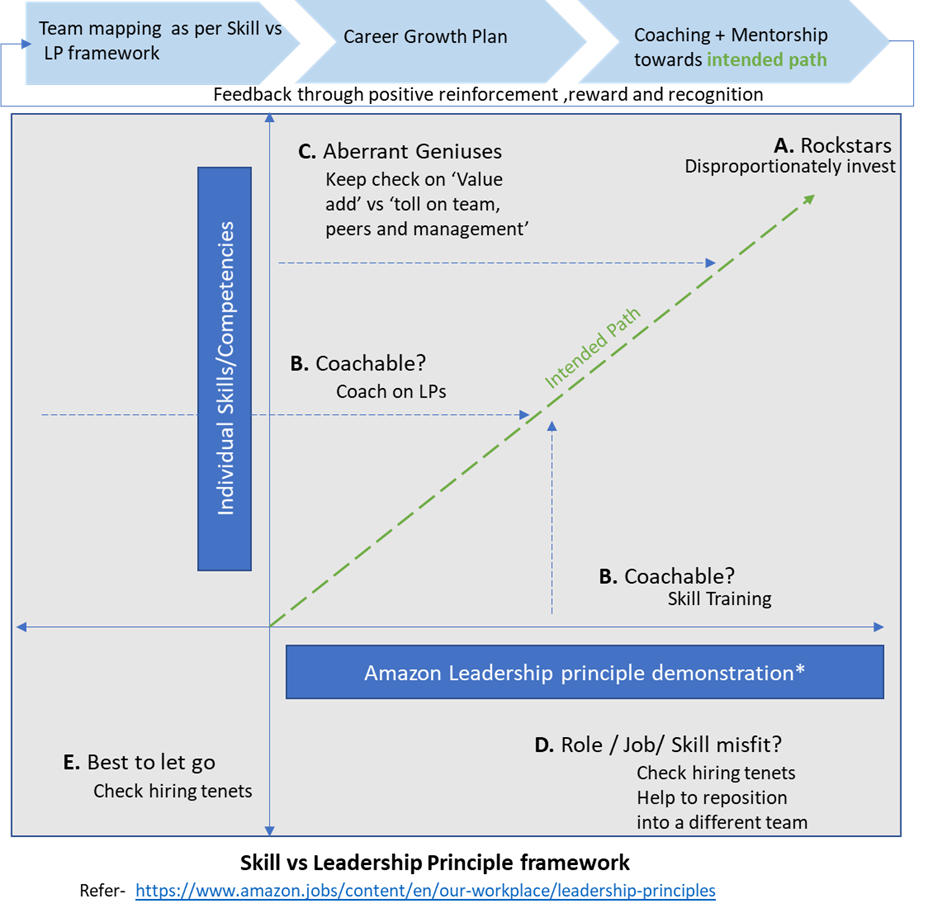
An organization is built on teams, and teams on people. At the center of the success of any org, always lies the hard and dedicated work of its people. The manager remains trusted to take care of their team, help them be more effective in the role and ensure success of each individual in the team- that’s the key role. The manager turns into a leader once they win the trust of their team members, and is able to motivate the team to deliver its best in the face of high ambiguity and adversity.
However, this journey is not easy for a manager and their team, and needs consistent nurturing. Any team will always be a mix of individuals with varied skills/competencies vs attitude (as demonstrated by Amazon Leadership principles (LP)). While everyone will understand what ‘level of skill’ means, Amazon LPs encapsulate how an employee should approach a problem or an idea to deliver long term gains for our customers. These are defined through tenets of customer obsession, ownership, earn trust, hire and develop best, deliver results, deep dive, think big, bias for action, invent and simplify, insist on high standards, have backbone; disagree and commit - to name a few of my favorites.
As a manager, one needs to plan for an individual’s career growth basis where each individual is on the Skill vs LP matrix. To simplify this, below is illustrated a simple high-level framework that captures the direction a manager can take for the growth and development of his team depending on the Skill vs LP position of an individual. This is inspired from my own experience, observations and wisdom from the book – Trillion Dollar Coach.

The objective of a people leader is to ensure their team progresses as per the ‘intended path’ to deliver org goals as well as achieve personal growth. A few positions of interest in the map are:
A. Rockstars are those who are the best performers and future leaders of the team. These are the people, where a leader will ensure disproportionate investment to keep high level of motivation and job satisfaction with an objective to retain them. They are role models for the team.
B. Coachable – As per the book, The Trillion Dollar Coach, the traits that make a person coachable include honesty and humility, the willingness to preserve and work hard, and a constant openness to learning. The first aspect to any coaching is for the coachee to be self-aware of his or her own strengths and weaknesses, and be honest with themselves on their flaws. The manager as a coach for this individual will help raise self-awareness further and enable them to see the flaws, that they don’t see for themselves, and in the process coach them towards the ‘intended path’.
C. Aberrant Geniuses – As per the book, The Trillion Dollar Coach, they are defined as High performing but difficult team members, who should be tolerated and even protected, as long as their behavior isn’t unethical or abusive and their value outweighs the toll their behavior takes on management, colleagues and teams. These are individuals with high skill who are better than others in many ways, and can deliver great products and high performing teams. The manager’s role here is to try to coach them past their aberrant behavior to maximize the genius, and always keep a check on how well they are collaborating with the teams, how often they are causing resentment in others affecting performance by a me-first attitude. The red flags to look for are - seeking too much attention and self-promotion at the cost of the team, and creating an environment where others are afraid to contribute and speak. It’s the manager’s role to strike a balance, and take a tough call when the aberrant genius outweighs the value they generate.
D. and E. represents people who are mis-hired as they fall short on skills. If coachable based on LPs, they should be found a role in a different team which suits their skills, else they should be let go. These hirings should always be retrospect to recalibrate the hiring bar, as letting go a wrongly hired person is always an expensive exercise on management bandwidth.
In summary, a manager who ensures every individual in the team is coached towards the intended path can evolve into a people leader delivering superior results and high performing teams. A manager needs to setup mechanism to share feedback through 1:1s, group meetings and also receive feedback through surveys that measure team’s morale, motivation, job satisfaction etc. A balanced approach with feedback loops, and rewards/recognition in private/public forums can help a manager drive every individual towards their intended path, and pave a route for every individual to deliver to the best of their ability and turn into future Rockstars for the organization.
written by

Subrata Saharia 3rd+
Senior Manager, Program Management at Amazon
- Log in to post comments






